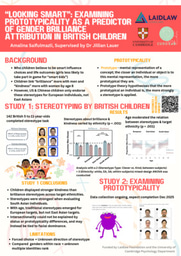"Looking smart”: Examining Prototypicality as a predictor of gender brilliance attributions across White, East-Asian and South-Asian racial groups in British Children - Paper
Globally, women are underrepresented in Science, Technology, Engineering and Mathematics (STEM) fields. One explanation for this is the impact of stereotypes, such as the male gender brilliance which associates men with intellectual talent. Therefore, it is important to understand stereotypes to support equality. Across cultures, children endorse male gender brilliance and recent work suggests that American children’s endorsement of this stereotype varies across racial-ethnic groups, emerging early in development for sterotying White individuals but not for East Asian or Black individuals. Study 1 aims to investigate whether these patterns replicate in the British context and extend prior work by examining children’s stereotypes toward an understudied racialethnic group: South Asian individuals. In Study 1, 142 British children aged 5–11 completed the stereotype task assessing their gender-brilliance stereotypes toward targets from three racial-ethnic groups: East Asian, South Asian, and White individuals. Children associated brilliance significantly more with South Asian men than South Asian women, and more with White men than White women. However, they displayed the reverse stereotype for East Asian targets. Notably, gender-brilliance stereotypes were strongest when children evaluated South Asian individuals. These findings challenge the notion that children endorse gender-brilliance stereotypes primarily when stereotyping White individuals. Study 2 aims to further test the theory that those belonging to low-status racial groups, such as East-Asians, may escape from the gender brilliance stereotype by virtue of their non- prototypicality. Participants complete a prototypicality task and a stereotype task to see if the former can predict the later. Data collection for Study 2 is ongoing and expected to be completed by December 2025.

Please sign in
If you are a registered user on Laidlaw Scholars Network, please sign in